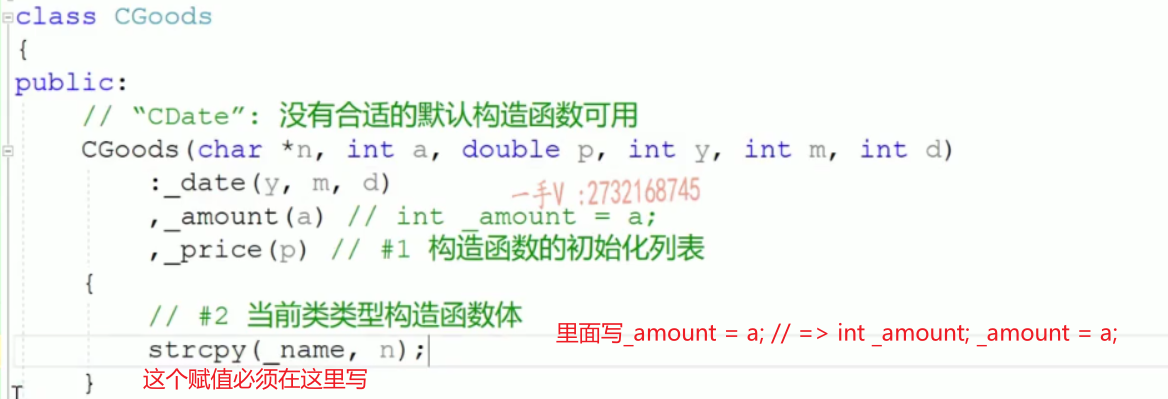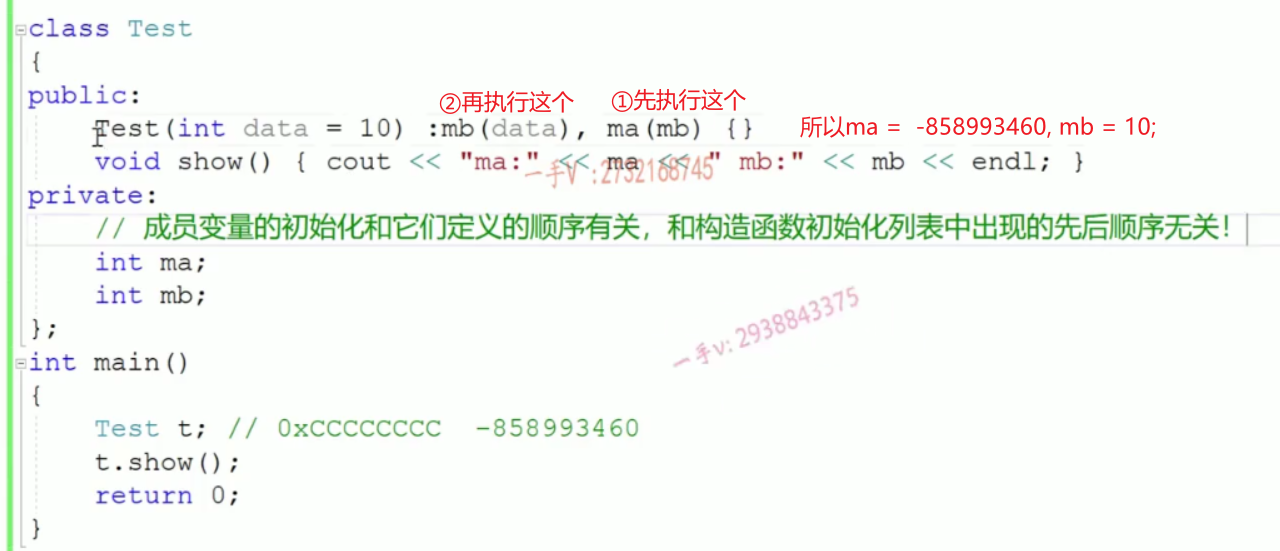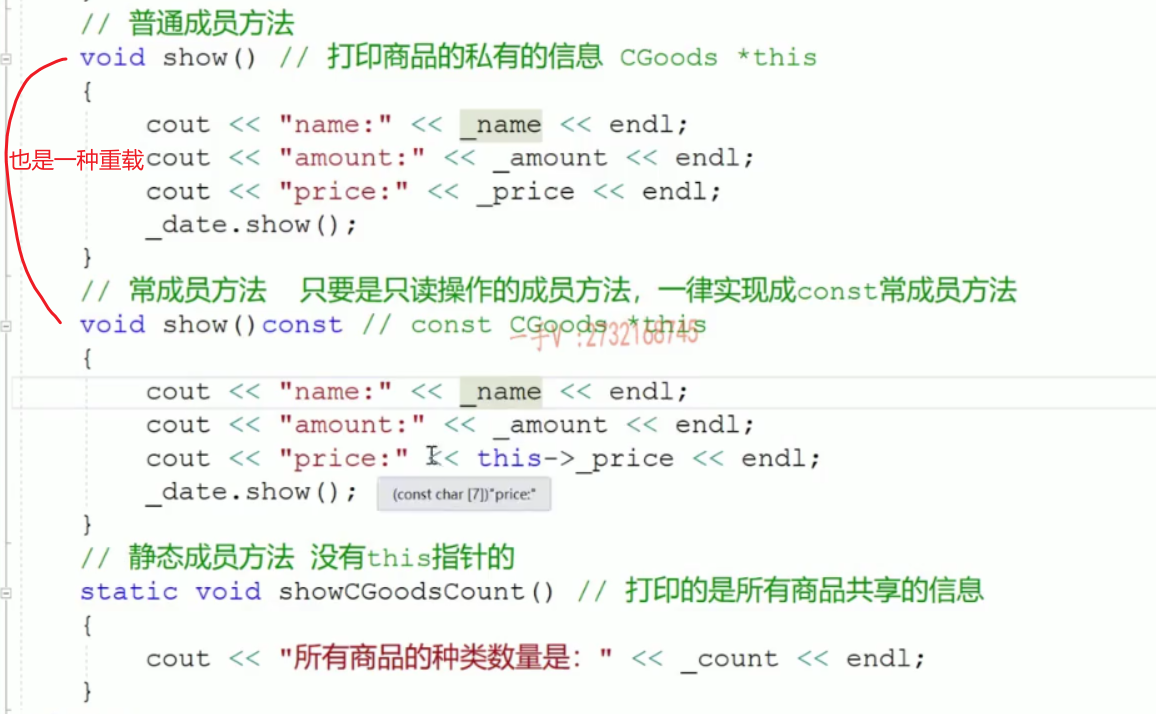深入C++03:面向对象
📕面向对象
类和对象、this指针#
不用做太多笔记,都可以看初识C++的笔记;
记住👀:声明后面都要加“;”,比如声明方法和变量还有class结束的地方;而实现函数出来的地方是不需要加“;”
为什么要按最大字节对齐?和内存池相关
掌握构造函数和析构函数#
看初始C++笔记enough;
掌握对象得深拷贝和浅拷贝#
浅拷贝:直接内存数据拷贝
SeqStack s;//默认构造函数;
SeqStack s2 = s;//调用拷贝构造函数;
SeqStack s3(s);//上下都是调用拷贝构造函数,类会有默认拷贝函数,如默认构造函数相同,不写会自己生成;
//(什么时候调用什么函数查看下面代码实践);

容易错点:类对象含有对象内存之外的资源,比如说在堆中有内存资源,那么调用析构函数会发生错误;

深拷贝:自定义拷贝构造函数和重载=运算符
深拷贝原型例子:

问题一:为什么C++面向对象里面拷贝数据的时候用for循环,不用memcpy(ptmp, _pstack, sizeof(int)* _size)或者relloc()?
因为memcpy和relloc都是浅拷贝,如果数据只是int、float这种简单类型,不会用到外部资源就没有什么问题,还是可以用这两个函数拷贝数据的,但是如果数据内是对象,对象内有指向外部内存,那么就会有浅拷贝的问题出现(delete了可以放弃的数据,会发现转移的数据也被释放了)。

问题二:直接赋值不是浅拷贝操作吗?采用直接赋值操作怎么实现深拷贝呢?
一开始说两者SeqStack s2 = s; SeqStack s3(s);都是有默认拷贝函数和默认的赋值函数,两个效果是相同的,都是直接拷贝内存数据;
void operator=(const SeqStack &src) {
_pstack = src._pstack;
_top = src._top;
_size = src._size;
}
//这个默认赋值函数还有一个问题:假设s, s2都初始化,这时候将s2 = s, s2中_pstack指向的内存(在构造函数时申请的空间)会没有指针指到,因为s2中的_pstack指向了 s中_pstack指向的空间(因为是浅拷贝啊!)
//所以我们重载赋值函数时要注意这个问题!
所以,赋值函数=我们需要运算符重载;
实例:
void operator=(const SeqStack &src) {
//防止自赋值,自赋值如果不防止会出现内存访问异常,自己分析一下即可;
if (this == &src) return;
//需要先释放当前对象占用的外部资源
delete []_pstack;
//进行拷贝,和拷贝构造一样的操作
_psatck = new int[src.size];
for (int i = 0; i <= src._top; i++) {
_pstack[i] = src._pstack[i];
}
_top = src._top;
_size = src._size;
}
浅拷贝有问题的时候再考虑深拷贝;
类和对象代码应用实践#
①简写实现String类
#include<iostream>
#include<cstring>
using namespace std;
class String {
public:
String(const char * str = nullptr) {//构造函数
if (str != nullptr) {
m_data = new char[strlen(str) + 1];//strlen函数不会读取'\0';
strcpy(this->m_data, str);
cout << "调用有参数的构造函数" << endl;
}
else {
m_data = new char[1]; //这样不管为不为空,strlen都可以访问
*m_data = '\0';
cout << "调用没有参数的构造函数" << endl;
}
}
~String() {//析构函数
delete m_data;
m_data = nullptr;
}
String(const String &other) { //拷贝函数
m_data = new char[strlen(other.m_data) + 1];
strcpy(m_data, other.m_data);
cout << "调用拷贝函数" << endl;
}
String& operator=(const String &other) {//=运算符重载,String& 是为了支持连续使用=
if (this == &other) return *this;//注意,这里不能返回other,因为other有const修饰
cout << "调用=赋值函数" << endl;
delete m_data;
m_data = new char[strlen(other.m_data) + 1];
strcpy(m_data, other.m_data);
return *this;
}
private:
char *m_data; //保存字符,要用深拷贝
void resize() {
}
};
int main () {
//调用带const char*参数的构造函数;
String str1;
String str2("hello");
String str3 = "world"; //一定条件下成立,刚刚好, 问题:为什么这个也可以调用构造函数?编译器优化相关
String *test = new String("lulu");
//调用拷贝构造函数
String str4 = str3;
String str5(str3);
//调用赋值重载函数
str1 = str2; //必须已经声明
return 0;
}

②循环队列
#include<iostream>
using namespace std;
class Queue {
public:
Queue(int size = 15) { //构造函数
_pQue = new int[size];
_front = _rear = 0;
_size = size;
}
~Queue() { //析构函数
delete []_pQue;
_pQue = nullptr;
}
void push(int val) {
if (full()) resize();
_pQue[_rear] = val;
_rear = (_rear + 1) % _size;
}
void pop() {
if (empty()) return;
_front = (_front + 1) % _size;
}
int front() {
if (empty()) return -1;
return _pQue[_front];
}
bool empty() {
return _front == _rear;
}
bool full() {
return (_rear + 1) % _size == _front;
}
// Queue(const Queue &que) = delete; //不允许使用拷贝构造函数;
Queue(const Queue &que) { //拷贝构造函数
_front = que._front;
_rear = que._rear;
_size = que._size;
_pQue = new int[_size];
// for (int i = 0; i < _size; i++ ) {//这样写有些值不存在,而且浪费时间,遍历到了不用的值
// _pQue[i] = que._pQue[i];
// }
for (int i = _front; i != _rear; i = (i + 1) % _size) { //rear在的值是空的
_pQue[i] = que._pQue[i];
}
}
// Queue& operator=(const Queue &que) = delete; //不允许使用拷贝构造函数;
Queue& operator=(const Queue &que) { //赋值函数
if (this == &que) return *this;
delete []this->_pQue;
_front = que._front;
_rear = que._rear;
_size = que._size;
_pQue = new int[_size];
for (int i = _front; i != _rear; i = (i + 1) % _size) { //raer在的值是空的
_pQue[i] = que._pQue[i];
}
return *this;
}
private:
int *_pQue; //队列的数组空间, 存在堆空间,类对象外空间,需要深拷贝
int _front; //队头位置
int _rear; //队尾位置
int _size; //队列扩容总大小;
void resize() { //扩容函数,注意实现
int *newQue = new int[_size * 2];
int index = 0;
for (int i = _front; i != _rear; i = (i + 1) % _size) {
newQue[index++] = _pQue[i];
}
delete []_pQue;
_pQue = newQue;
_front = 0;
_rear = index;
_size *= 2;
}
};
int main() {
Queue que;
for (int i = 0; i < 20; i++) {
que.push(i);
}
while(!que.empty()) {
cout << que.front() << " ";
que.pop();
}
return 0;
}

掌握构造函数得初始化列表#
①初始化列表和和构造函数函数体内写有什么区别?
可以去看看汇编代码

②初始化列表的顺序是以类中成员变量的声明顺序去初始化的,而不是在初始化列表中出现的顺序!

掌握类得各种成员方法以及区别#
const、static、以及什么都不加,他们修饰的方法很花里胡哨,但是实际上就是this指针的区别;

三者成员函数的实例:

指向类成员的指针#
直接看实例:
#include<iostream>
#include<vector>
class Test {
public:
void fun() {std::cout << "call Test::fun" << std::endl;};
static void static_fun() {std::cout << "call Test::static_fun" << std::endl;};
int ma;
static int mb;
};
int main() {
Test t1;
Test *t2 = new Test();
//操作普通成员变量,必须要①声明有Test作用域的指针,②有对象
int Test::*p = &Test::ma;
t1.*p = 20;//改变了t1中ma的值
t2->*p = 20;//改变了t2中ma的值;
//操作静态成员变量,直接用同类型指针操作即可
int *p1 = &Test::mb;
*p1 = 40;//改变了静态成员变量mb的值;
//操作普通成员函数,必须要①声明有Test作用域的指针,②有对象
void (Test::*pfun)() = &Test::fun;
(t1.*pfun)();
(t2->*pfun)();
//操作静态成员函数,直接用同类型的指针即可
void (*pstatic_fun)() = &Test::static_fun;
return 0;
}



【推荐】国内首个AI IDE,深度理解中文开发场景,立即下载体验Trae
【推荐】编程新体验,更懂你的AI,立即体验豆包MarsCode编程助手
【推荐】抖音旗下AI助手豆包,你的智能百科全书,全免费不限次数
【推荐】轻量又高性能的 SSH 工具 IShell:AI 加持,快人一步
· 无需6万激活码!GitHub神秘组织3小时极速复刻Manus,手把手教你使用OpenManus搭建本
· Manus爆火,是硬核还是营销?
· 终于写完轮子一部分:tcp代理 了,记录一下
· 别再用vector<bool>了!Google高级工程师:这可能是STL最大的设计失误
· 单元测试从入门到精通